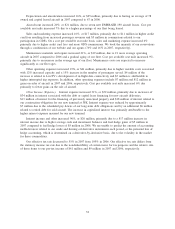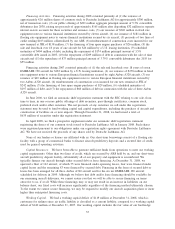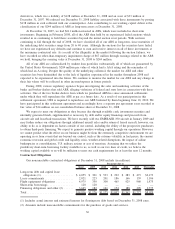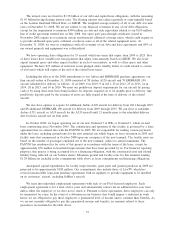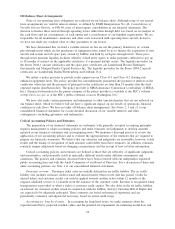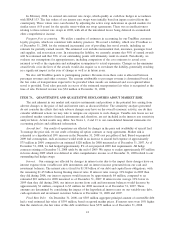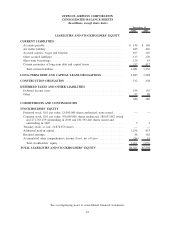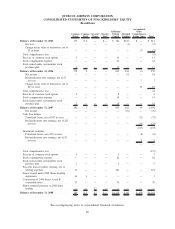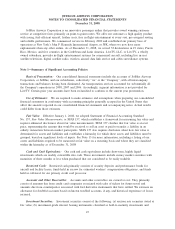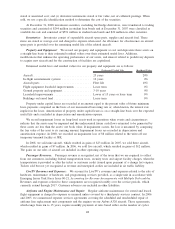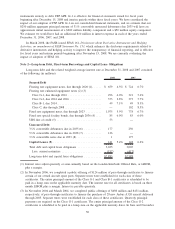JetBlue Airlines 2008 Annual Report Download - page 49
Download and view the complete annual report
Please find page 49 of the 2008 JetBlue Airlines annual report below. You can navigate through the pages in the report by either clicking on the pages listed below, or by using the keyword search tool below to find specific information within the annual report.risk being hedged (i.e. aircraft fuel) on both a historical and prospective basis and (3) cash flow designation
for each hedging transaction executed, to be developed concurrently with the hedging transaction. This
documentation requires that we estimate forward aircraft fuel prices since there is no reliable forward market
for aircraft fuel. These prices are developed through the observation of similar commodity futures prices, such
as crude oil and/or heating oil, and adjusted based on variations to those like commodities. Historically, our
hedges have settled within 24 months; therefore, the deferred gains and losses have been recognized into
earnings over a relatively short period of time.
Fair value measurements. We adopted Statement of Financial Accounting Standard No. 157, Fair Value
Measurements, or SFAS 157, which establishes a framework for measuring fair value and requires enhanced
disclosures about fair value measurements, on January 1, 2008. SFAS 157 clarifies that fair value is an exit
price, representing the amount that would be received to sell an asset or paid to transfer a liability in an orderly
transaction between market participants. SFAS 157 also requires disclosure about how fair value is determined
for assets and liabilities and establishes a hierarchy for which these assets and liabilities must be grouped, based
on significant levels of inputs. We rely on unobservable (level 3) inputs, which are highly subjective, in
determining the fair value of certain assets and liabilities including ARS and our interest rate swaps.
ARS are long-term debt securities for which interest rates reset regularly at pre-determined intervals,
typically 28 days, through an auction process. We held ARS, with a total par value of $311 million and
$611 million as of December 31, 2008 and 2007, respectively. Beginning in February 2008, all of the ARS held
by us experienced failed auctions which resulted in our continuing to hold these securities beyond the initial
auction reset periods. With auctions continuing to fail through the end of 2008, we have classified all of our
ARS as long term, since maturities of underlying debt securities range from 20 to 40 years. Although the
auctions for the securities have failed, $18 million have been redeemed by their issuers at par, we have not
experienced any defaults and continue to earn and receive interest on all of these investments at the maximum
contractual rate. At December 31, 2007, these securities were valued based on the markets in which they were
trading, a level 1 input, which equaled their par value. The estimated fair value of these securities at
December 31, 2008, however, no longer approximated par value and was estimated through discounted cash
flows, a level 3 input. Our discounted cash flow analysis considered, among other things, the quality of the
underlying collateral, the credit rating of the issuers, an estimate of when these securities are either expected to
have a successful auction or otherwise return to par value and expected interest income to be received over this
period, which was estimated to be an average of eight years. Because of the inherent subjectivity in valuing
these securities, we also considered independent valuations obtained for each of our ARS held as of
December 31, 2008 in estimating their fair values.
All of our ARS are collateralized by student loan portfolios (substantially all of which are guaranteed by
the United States Government), $284 million of which had a AAA rating and the remainder had an A rating.
Despite the quality of the underlying collateral, the market for ARS and other securities has been diminished
due to the lack of liquidity experienced in the market throughout 2008 and expected to be experienced into the
future. Through September 30, 2008, we had experienced a $13 million decline in fair value, which we had
classified as temporary and reflected as an unrealized loss in other comprehensive income. Through the fourth
quarter, however, the lack of liquidity in the capital markets not only continued, but deteriorated further,
resulting in the decline in fair value totaling $67 million at December 31, 2008. This decline in fair value was
also deemed to be other than temporary due to the continued auction failures and expected lack of liquidity in
the capital markets into the foreseeable future, which resulted in an impairment charge being recorded in other
income/expense. We continue to monitor the market for our ARS and any change in their fair values will be
reflected in other income/expense in future periods.
We have elected to apply the fair value option under Statement of Financial Accounting Standard 159,
The Fair Value Option for Financial Assets and Financial Liabilities, to an agreement with one of our ARS’
broker, to repurchase, at par. We recorded a $14 million gain associated with fair value of this put option,
which offsets $15 million of related ARS impairment included in other income/expense. The fair value of the
put is determined by comparing the fair value of the related ARS, as described above, to their par values and
also considers the credit risk associated with the broker. This put option will be adjusted on each balance sheet
date based on its then fair value. The fair value of the put option is based on unobservable inputs and is
therefore classified as level 3 in the hierarchy.
40




